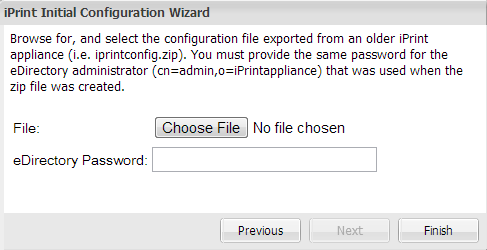5.1 Setting Up iPrint Appliance
You can set up iPrint Appliance as a new copy, or you can upgrade from an earlier version.
-
On a Web browser, use either the DNS name or the IP Address to access the Management Console. For example, https://10.0.0.1:9443 or http://iprint.example.com/admin.
Ignore the security certificate warning, and continue to the iPrint Appliance Management Console. To avoid the security warning prompt every time you access the iPrint Appliance Management Console, you can add the certificate to the trusted certificates list on your browser.
-
Specify vaadmin or root as the user name.
-
Specify the password, then click Log in.
The Management Console page is displayed.
-
Click iPrint Appliance Configuration.
The iPrint Initial Configuration Wizard window is displayed.
-
Select New or Upgrade, then click Next.
5.1.1 New
-
Specify the following information:
Table 5-1 iPrint Initial Configuration Wizard
General
Authentication Realm: Specify the authentication domain. All the Windows and Mac desktop clients on your network authenticate against the Authentication Realm.
iPrint Appliance has its own internal user store. Therefore, independent Authentication Realms are possible. The administrator can setup each appliance to only use its internal user store, or integrate with other user sources by using the LDAP Import feature. The administrator can set the Authentication Realm independently for each iPrint Appliance, or use the same Authentication Realm on all appliances for a single-sign-on ability.
DNS for Print Manager: Specify the DNS name in the format displayed in the box. It is recommended that you do not use the DNS name of iPrint Appliance. Specify a DNS name that follows the Print Manager.
The DNS name is important for the Windows and Mac desktop clients. It allows you to move the server without interrupting the workstations. The DNS name must resolve to the IP address of the Appliance. You must validate that the DNS address is correct and functional before continuing because a wrong DNS address can result in errors.
The DNS name is also known as a CNAME record. It is a DNS name tied to a service, rather than a server. If you choose to specify a CNAME record, ensure that the chosen name resolves to the IP address of iPrint Appliance.
Embedded Data Store
The credentials in this section are used to log in to the iManager interface.
Administrator Username: The administrator account user name is pre-populated in the following format: cn=admin,o=iPrintAppliance. This field is not editable.
Administrator Password: Specify the password for the administrator account. Administrator password is the eDirectory administrator Password. It is used for eDirectory and iManager.
Re-type Password: Specify the password again to confirm.
Driver Store
Local: If you want to use a local Driver Store, select Local. You can manage the Local Driver Store using iManager.
Remote: If you have an existing Driver Store configured with another iPrint Appliance or OES server, you can use that Driver Store by selecting the Remote option, then specifying the DNS Name/Address, User name and Password of the server containing the Driver Store.
You can share the Driver Store with all your appliances and even your existing OES environment. This allows you to upload drivers to a single source and share the drivers with all appliances on your network. The Driver Store simplifies administration effort across your enterprise.
NOTE:Specify the admin credentials in FDN format (for example, cn=admin,o=companyname) of the server where the Driver Store resides.
NOTE:If you configure a Remote Driver Store, you must manage (using iManager) the Remote Driver Store from the machine where the Driver Store resides.
-
Click Finish.
After configuring iPrint Appliance, you must create printers. You can create printers using the Management Console. If you have an existing iPrint Appliance or OES iPrint system, you can also import printers. To create printers, see Section 5.4, Creating Printers.
5.1.2 Upgrade
When upgrading to a new version of iPrint Appliance from an older version, ensure that the newly deployed version of iPrint Appliance has the same network configuration, passwords, and time zone as that of the older version of iPrint Appliance from which you exported the iprintconfig.zip configuration file. For more information about iprintconfig.zip, see Section 3.6.1, Exporting the Configuration File.
-
On a web browser, use either the DNS name or the IP Address to access the Management Console. For example, https://10.0.0.1:9443 or http://iprint.example.com/admin.
Ignore the security certificate warning, and continue to the iPrint Appliance Management Console.
-
Specify vaadmin or root as the user name.
-
Specify the password.
The Management Console page is displayed.
-
Click iPrint Appliance Configuration.
The iPrint Initial Configuration Wizard window is displayed.
-
Select Upgrade, then click Next.
-
In the File option, click Choose File, then select the configuration file exported from a previous copy of iPrint Appliance.

-
Specify the eDirectory Password.
NOTE:eDirectory Password is the password that you specified when exporting the configuration file from the previous copy of iPrint Appliance.
-
Click Finish.
IMPORTANT:If you have an existing remote renderer with the iPrint appliance, then post-upgrade of this appliance, you must download, install, and register the new remote renderer from the Management Console. You must upgrade the renderer, else it remains in inactive state.
If you are using a FireFox browser, on successful upgrade, you might not receive a completion message, even if the upgrade is successful.
5.1.3 Post-Upgrade
-
If the iPrint Appliance you are upgrading from uses third party certificates, then post-upgrade perform the following steps on the iPrint Appliance 1.1:
-
Modify the passphrase of the certificate in the /etc/ssl/servercerts/passphrase.sh file:
#!/bin/bash echo "changeit"
Replace the string changeit to the passphrase that you used when generating the certificate key.
-
Modify the SSLCertificateChainFile attribute in the /etc/apache2/vhosts.d/vhost-ssl.conf file to iPrint Appliance 1.1 certificate chain file location.
-
Restart the Apache service using the following command:
rcapache2 restart
-